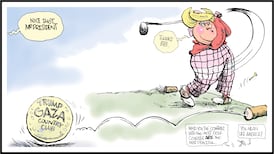One sign of vibrant cultural activity in any city is the advertisement of cultural events. For nearly four decades in Dublin city, these posters were seen on hoardings, walls and derelict buildings. But at the end of 2021, Irish Poster Advertising Ltd (IPA), the outdoor cultural and entertainment poster company, went into liquidation after 36 years in operation. It’s an under-reported victim of lockdown and more collateral damage of an era that decimated the live events industry.
Now, as people walking, cycling or driving around the capital may have noticed, the advertisement of independent cultural events on these poster sites is finished. The boards are being removed. With them goes the opportunity for small promoters, up-and-coming bands, small theatres, small arts and gig venues and so on to promote themselves in the public realm. There is no chance that most of these cultural and artistic entities can stretch to the budget that larger advertisers with larger billboard sites demand, which can be between €5,000 and €10,000 for a fortnight or a month.
This may not seem like a significant thing to the average punter. But these posters were a part of Dublin city’s literal cultural landscape and streetscape for almost four decades. They informed the public about cultural events and were a vital source of information, especially before things were advertised online, but also up until and during the era that events were promoted online.
They also, paradoxically, sprang to life during the pandemic. In the summer of 2020, noticing that gig posters were being removed because shows had been cancelled, the events promoter and restaurant consultant Anthony Remedy, the fashion stylist Corina Gaffey and the photographer Naomi Gaffey created the Positive Space, a city-wide exhibition of gorgeous images from photographers. These poster-photographs populated the empty posters sites and brought a sense of beauty to the city during a very grim time.
Tight margins
The Irish Poster Association operated on tight margins. They would frequently cut deals for smaller arts events. They had a “band rate” meaning a young band could get a poster of themselves to advertise an album release or a gig for as little as €5. Larger promoters such as MCD and Aiken Promotions were a source of continuous income for the IPA, and the fees they were charged helped underwrite posters for smaller entities. But with the chaos of lockdown and the cancellation of live events this source of revenue also stalled. On top of that, the rolling postponements and changing dates of live concerts, theatre, festivals and so on meant that reprinting posters with new dates became impractical.
Even before the pandemic the space for cultural posters was getting squeezed. It used to be the case that IPA would make deals with builders putting up hoardings, get insurance and pay rates, but the sites were increasingly curtailed, with builders wanting to advertise themselves on their hoarding sites. Many artists, promoters and smaller venues were already using social media to communicate to the public what they were up to, or what was being programmed, or what music was being released, or which books being published, and so poster advertising was already up against it. But it was surviving, and artists and organisers appreciated and valued the power and joy of posters.
Such posters are instant archive material. They are the ephemera of a social and cultural scene. They are objects that speak to the existence of culture in a city. In other cities there’s no greater sign to me of a thriving arts, events and nightlife scene than the texture of posters pasted up or mounted everywhere, or the large leaves of posters that accumulate on top of each other, like rings on a tree, visually articulating the parties and plays, gigs and festivals, readings and events that have come and gone. They also support an ecosystem beyond the thing they’re advertising, including graphic designers, illustrators and printers.
Professionalisation
Pat Egan, the legendary promoter who headed up IPA, began his poster advertising business in the 1980s, in his 30s, when he wrote to the council pitching a professionalisation of the activity in the city. That pitch worked. It excelled. For 36 years, passers-by noted what gigs were on, and artists got a kick out of seeing their events broadcast to the city.
When I spoke to Egan last Friday, he reflected on an era and activity that, without new support from the council or elsewhere, looks to be consigned to history. It’s an unfortunate evolution, especially at time when some younger people, having embraced the digital sphere, are now often turning back to analogue materials such as flyers and zines. “As a promoter, my cycle is almost complete,” Egan said. “It’s just a changing landscape. If you had a good time from it, and it lasted a good bit of your life, then that’s that.”
There is something metaphorical about the end of such literal signs. It speaks to the erosion of independent cultural activity in the capital, the destruction of the cultural habitat of the city through regressive development and the erasure of underground, fringe, experimental or avant-garde scenes caused by the dearth of DIY and independent cultural spaces, high rent and the housing crisis.
Many interesting and interested artists are fighting hard, and there are stimulating alternative cultural events popping up, and they should be celebrated and supported. But, big picture, a city devoid of literal and figurative texture is a boring one, even when it comes to something as simple – and now nostalgic – as posters on a wall.
















